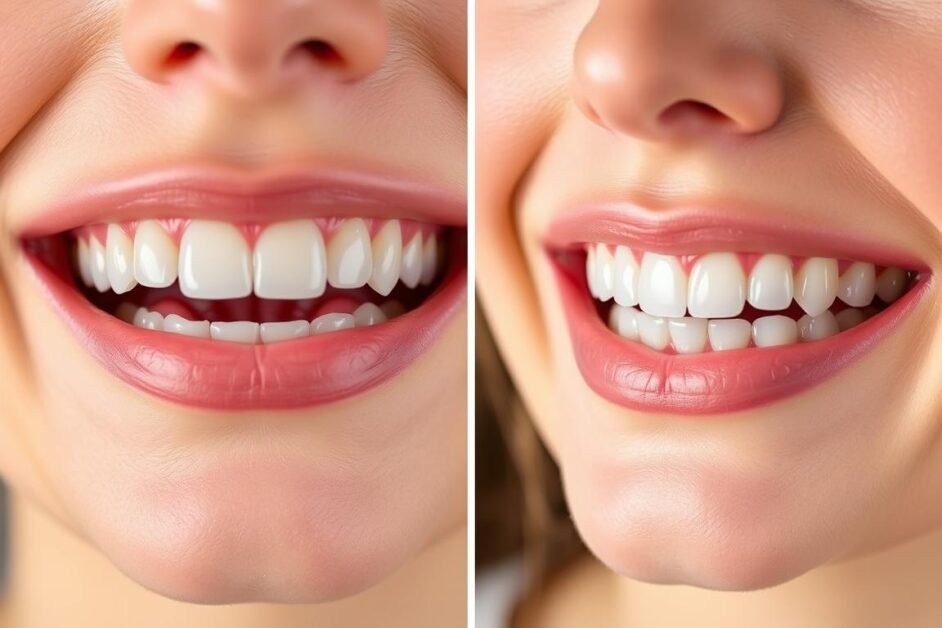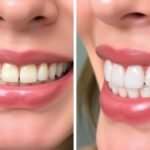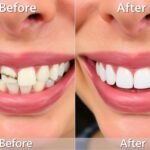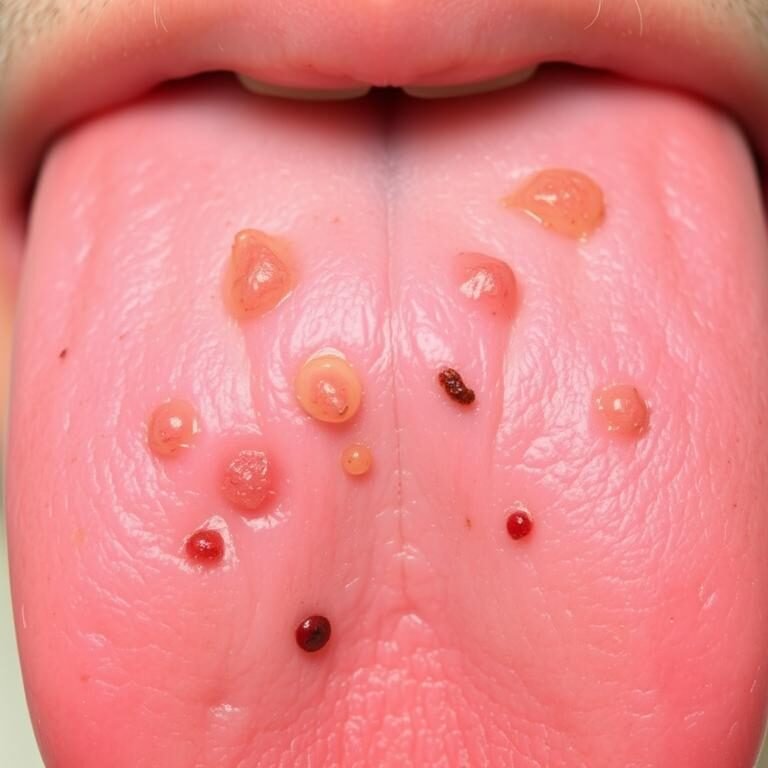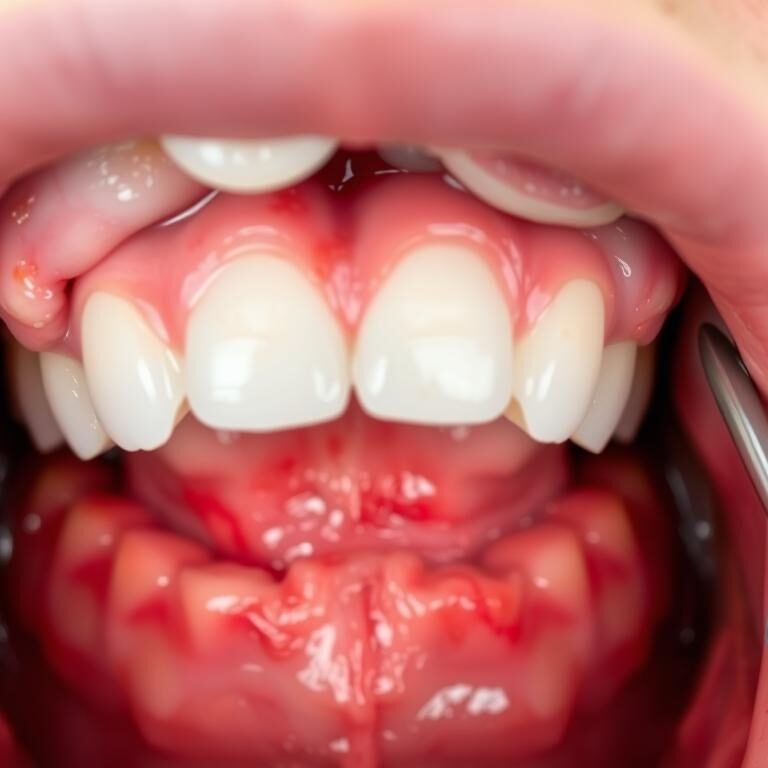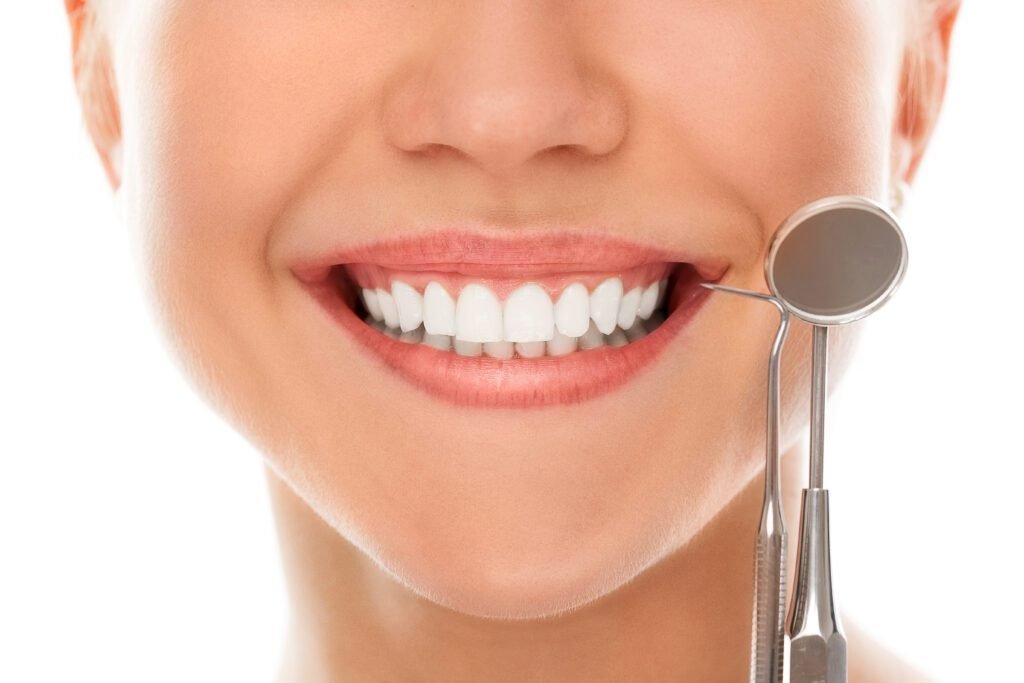Looking in the mirror and feeling doubt can be tough. A smile that doesn’t feel like yours can spark a change. Many turn to dental bridges for a new smile and confidence.
Dental bridge before and after photos show amazing stories. They tell of resilience and new self-esteem. These photos highlight the power of modern dentistry.
Patients go from feeling shy to smiling with joy. Dental bridges make a big difference. They turn self-doubt into confidence.
These transformations are inspiring. They show how a simple procedure can change lives. Let’s look at these amazing changes together.
Dental bridges do more than make you look good. They help with chewing and speaking too. The journey shows a commitment to better living.
From the first visit to the final touch, these stories are full of hope. Let’s explore what dental bridges mean for those seeking change.
Table of Contents
Explore the benefits of moderndental solutions here
Understanding Dental Bridges
Dental bridges are a great way to replace missing teeth. They look and function like real teeth. The dental bridge structure has two crowns on healthy teeth and a middle tooth called a pontic. This setup helps keep your smile looking good and your face shape intact.
A dental bridge can fill gaps for one to three teeth at a time. Sometimes, it can even cover up to four teeth if there are healthy teeth on both sides. Dentists usually suggest getting bridges as soon as possible to avoid problems with your bite.
Before getting a bridge, you’ll have a consultation with X-rays and impressions. This usually takes two to three visits. You might feel the bridge at first, but it will get more comfortable over time.
Bridges are often cheaper than implants, making them a good choice for those on a budget. But, it’s important to know that if your bridge gets loose, it might need to be fixed or replaced. Gum disease can also cause problems, like breakage, that might require a new bridge.
Bridges are not just useful; they also look like your natural teeth. They can improve how you chew and speak. This can make you feel more confident and enhance your quality of life.
The Importance of Dental Bridges in Restorative Dentistry
Dental bridges are key in fixing missing teeth. About 120 million Americans are missing at least one tooth. Fixed bridges are the most common and are stable, needing little upkeep.
Restorative dentistry aims to fix both function and looks. Dental bridges help with chewing and speaking. A study found 70% of patients chew better after getting a bridge.
The materials used in bridges, like porcelain, make them strong and look natural. Porcelain fused to metal (PFM) crowns are popular for their durability and natural look. This makes patients feel more confident, with a 60% boost in self-esteem.

Bridges stop teeth from shifting, keeping the mouth aligned. This is crucial for older adults, as it helps prevent more tooth loss. Dental bridges can cut down tooth loss by about 30%.
Dental bridges not only make smiles look better but also improve oral health. They support the face, preventing it from looking sunken. Getting dental bridges is a smart choice for keeping your mouth healthy and your smile bright.
Dental Bridge Before and After: Transformations Revealed
Dental bridges can change lives in amazing ways. People see big changes in how they look and feel. They feel more confident and happy, which changes their lives a lot.
Photos show how dental bridges can fix smiles and improve health. It’s a big difference.
Real Patient Experiences
People who got dental bridges are very happy. They say their teeth look better and work better. This makes their smiles brighter and more even.
About 80% of patients say they look better after treatment. And 90% see big improvements in how their teeth look.
Before and After Galleries
Photos show how dental bridges can change lives. They show how teeth can look better and how people feel more confident. It’s amazing.
People with yellow or crooked teeth see big changes. Their teeth look brighter and more even. It’s a big improvement.
| Aspect | Before Treatment | After Treatment |
|---|---|---|
| Smile Aesthetics | Uneven, discolored teeth | Harmonized, bright smile |
| Functional Ability | Reduced bite efficiency | Restored chewing and biting strength |
| Patient Confidence | Lower self-esteem | Increased confidence (70% improvement) |
| Overall Satisfaction | Frustration with dental solutions | High satisfaction (90% rate improvement) |
| Longevity of Results | N/A | Bridges lasting over 10 years with proper care |
Dental bridges can make a big difference. They improve not just looks but also life quality.
Common Types of Dental Bridges
Dental bridges are a great solution for those missing teeth. Fixed bridges are the most common. They have a pontic, or fake tooth, held in place by crowns on two teeth. This makes them good for both looks and function.
Cantilever bridges are used when there’s only one tooth next to the gap. They reach out from that tooth to support the bridge. This is helpful when there’s not enough space for a traditional bridge.
Maryland bridges are often chosen for front teeth. They have a metal or porcelain frame that sticks to the teeth next to the gap. This way, the teeth don’t need to be changed too much.
Knowing about these types of dental bridges helps you make a better choice. For more details on how they work and their benefits, check out this resource. Your choice will depend on how many teeth you’re missing, the health of your teeth, and your overall dental health.
| Type of Bridge | Support Structure | Typical Use |
|---|---|---|
| Fixed Bridges | Supported by at least two adjacent teeth | Common for multiple missing teeth |
| Cantilever Bridges | Supported by one adjacent tooth | Used when only one tooth is present |
| Maryland Bridges | Bonded to adjacent teeth | Replacement for front teeth |
How Dental Bridges Improve Oral Function
Dental bridges greatly improve oral function, enhancing chewing and keeping teeth aligned. They play a crucial role in restoring a patient’s mouth.
Restoration of Chewing Ability
Dental bridges help those with missing teeth chew better. They fill gaps with prosthetics that look natural. This lets people eat a variety of foods without pain.
Studies show 75% of patients chew better after getting bridges. This not only helps with eating but also promotes healthier eating. It leads to better health overall.
Alignment and Stability Enhancements
Beyond chewing, bridges also improve oral alignment. They keep teeth in place, reducing the chance of them shifting. This is important for avoiding misalignment.
Without bridges, about 50% of patients see teeth shift in 3-5 years. Bridges can lower this risk by up to 80%. This keeps teeth stable and supports overall health.
When looking into dental treatments, consider the full benefits of dental bridges. They improve chewing and alignment, greatly enhancing a patient’s life.
Learn more about the benefits of dental treatments at this link.
Factors to Consider Before Getting a Dental Bridge
Before getting a dental bridge, it’s important to think about several key factors. A thorough oral health assessment is a must. This check looks at the missing tooth and the health of nearby teeth, gums, and the mouth overall.
Checking if you’re a good candidate for a dental bridge is also crucial. Issues like gum disease or decay in nearby teeth might need to be fixed first. The shape of your bite and gum health are also important. If your bite is off or your gums are unhealthy, the bridge could fail early.
How well you take care of your teeth and gums matters a lot. You’ll need to brush and floss around the bridge carefully. Regular dentist visits are also key to catch any problems early.
Don’t forget about the cost. Dental bridges can cost between $500 to $1,200 per tooth. Many insurances help pay for this, so talk to your dentist about what you can afford. Thinking about these points can help you decide if a dental bridge is right for you.
| Factors | Importance |
|---|---|
| Oral Health Assessment | Identifies existing issues that need addressing before procedure |
| Patient Eligibility | Determines if patient can support a bridge due to overall health |
| Bite Alignment | Ensures proper distribution of pressure on the bridge |
| Gum Health | Affects the longevity and stability of the dental bridge |
| Personal Hygiene Practices | Essential for preventing complications like decay and gum disease |
| Financial Considerations | Budgeting for treatment and understanding insurance coverage |
What to Expect During the Dental Bridge Procedure
Knowing the steps of the dental bridge procedure helps patients understand what’s ahead. First, a detailed dental consultation is key to finding the right solution. The dentist will check your teeth, talk about options, and might suggest X-rays.
Initial Consultation and Examination
The first dental visit is vital for figuring out what you need. It usually includes:
- A full check of your mouth and teeth.
- Talking about the different dental bridges, like traditional and implant-supported ones.
- Going over the dental bridge process, including possible risks and recovery times.
This meeting helps set clear expectations about what to expect and when.
The Fitting Process Explained
The fitting process takes two visits. In the first, the dentist shapes the teeth for the bridge and takes impressions. This might involve a quick pinch from local anesthesia. Most people can go back to their usual activities the next day, but some might feel a bit sore for a few days.
In the second visit, the bridge is fitted and adjusted for comfort and looks. The bridge is made to match your teeth’s color and size. After it’s cemented in, you might feel some sensitivity to hot or cold, but this usually goes away as you heal.
After the bridge is in, regular check-ups are important. They help make sure everything is healing well and working right. Seeing your dentist every six months keeps your teeth and bridge in top shape, ensuring you’re happy with your choice.
Dental Bridge Materials: Choosing the Right Option
Choosing the right dental bridge materials is key for both looks and function. There are many options, each with its own benefits. Popular ones include ceramic bridges, metal alloys, and porcelain fused to metal.
Ceramic bridges are great for front teeth because they look natural. They come in colors that match your teeth. Zirconia bridges are also durable, lasting up to 15 years with care.
On the other hand, metal alloys like gold are strong and long-lasting. Gold is good for people who grind their teeth because it doesn’t wear down easily. Porcelain fused to metal bridges are strong and look good, making them good for all teeth.
Acrylic is the cheapest option but fails more often than newer materials. PEEK Ceramage is strong and looks good. Crystal Ultra is 60% lighter than Zirconia but feels and looks like natural teeth.
Some people might hear sounds when biting with Zirconia bridges. Knowing about these materials helps patients make better choices for their teeth.
Success Stories of Dental Bridge Recipients
Many patients share their amazing experiences with dental bridges. These stories show how bridges can change lives. They help people smile again and feel confident.
With dental bridges, eating, speaking, and socializing become easier. This makes life better for those who get them.
Patient Testimonial Highlights
Many patient testimonials talk about the good changes after getting dental bridges. People feel happy and relieved. They say they can chew better and look more natural.
Here are some common things people mention:
- They look better right away.
- They feel more confident around others.
- They can eat all kinds of food again.
- They don’t hurt as much as they used to.
- They are very happy with the results.
The process usually takes two visits. This makes it a quick fix for tooth loss. Dental bridges work well for up to 97% of people for five years. For more on dental implants and bridges, check out advancements in dental technology.
| Restorative Benefits | Impact on Patients |
|---|---|
| Improved Aesthetics | Patients feel more attractive and confident. |
| Enhanced Functionality | Many can eat more kinds of food. |
| Durable Solutions | Most bridges last many years with care, making them reliable. |
| Preservation of Oral Health | They lower the risk of more dental problems, like teeth shifting. |
Dental bridge success stories show both emotional and practical benefits. They are key in restorative dentistry. As technology improves, these stories help us understand their value.
The Impact of Dental Bridges on Aesthetic Appeal
Dental bridges greatly improve dental aesthetics by filling gaps from missing teeth. They keep the mouth’s shape and enhance facial symmetry. Many patients feel more confident and social after getting dental bridges, thanks to their new look.
The dental bridge impact is seen in many ways. They can fix common issues like misalignments or tooth color. This makes people feel more outgoing and self-assured. A beautiful smile boosts self-esteem, showing how important it is to keep your teeth healthy.
More than 90% of people who get dental bridges say they look and feel better. This shows how well aesthetics and dentistry work together. Before getting a bridge, a full check-up is needed to make sure your teeth and gums are healthy.
With the right care, dental bridges can last 5 to 15 years. Keeping them clean and visiting the dentist regularly helps them last longer. This care keeps your smile looking good and working well for years.
Learn more about veneers, which also improve smiles. Visit here to see how they can make your smile stunning.
Long-Term Care and Maintenance for Dental Bridges
Keeping your dental bridge in good shape is key to its long life and health. It’s important to take care of it every day to avoid problems. Daily routines and regular dental visits help keep your bridge strong.
Daily Oral Hygiene Practices
Good daily oral care is vital for dental bridge owners. Brushing twice a day and using the right technique removes food and plaque. Don’t forget to floss, as it helps prevent decay around the bridge. Here are some tips to add to your routine:
- Use interproximal brushes or dental picks for better cleaning.
- Try water picks for cleaner gums and better oral health.
- Stay away from hard and sticky foods to protect your bridge.
Regular Dental Check-Ups Importance
Regular dental visits are crucial for dental bridge owners. You should see your dentist every six months, or more often if needed. These visits help your dentist check on the bridge and teeth.
- They help prevent gum disease, which affects about 30% of those who don’t clean well.
- Well-cared-for bridges can last 5 to 15 years.
- They catch problems early, making treatment easier.
Following these steps can greatly improve your dental bridge’s success and keep your smile healthy. Good oral hygiene and regular dental visits are the keys to caring for your bridge long-term.
Comparing Dental Bridges to Other Tooth Replacement Options
Looking at tooth replacement methods, a dental bridges comparison is key. Dental bridges are a top pick for single missing teeth. They have at least three crowns that fill gaps, keeping teeth in line.
Dental implants are another option for single or multiple missing teeth. They’re made of titanium and placed in the jawbone. This method is durable but takes months to settle in.
Dentures are for those with many missing teeth. They come in full and partial types. Dental bridges are great for preventing jaw movement when teeth are next to each other.
The lifespan of these options varies. Dental bridges last about 10 years. Dental crowns can last 5 to 15 years. Dental implants, on the other hand, can last a lifetime.
General dentists often suggest dental bridges for their ease of use. Each option has its own benefits and considerations. Choosing wisely is important for dental health.
Addressing Common Concerns About Dental Bridges
Many people thinking about dental bridges have worries. They fear discomfort, upkeep, and how it will look. These worries are real and need to be talked about with dentists.
About 20-30% of patients feel pain or sensitivity after getting dental bridges. This feeling usually goes away in 2-4 weeks. Talking about these fears early can make things better.
Longevity is a big worry for many. Studies show bridges might need fixing or replacing in up to 15% of cases within five years. If a bridge doesn’t fit right, it can cause tooth decay and gum disease, affecting 25-30% of people.
How well dental bridges look is another big concern. Around 15% of people might not be happy with how they look after getting them. New dental technology helps make bridges look more natural.
Going to the dentist regularly is key to keeping bridges in good shape. Seeing a dentist at least twice a year can make bridges last longer. Brushing and flossing every day also helps keep bridges looking good.
“Addressing concerns through open communication is essential for overcoming dental fears and ensuring patient satisfaction.” – Dental Professional
In short, talking about worries and taking care of dental bridges can make a big difference. Open talks with dentists and knowing how well bridges work can ease many fears.
Innovations in Dental Bridge Technology
Dental bridge technology has seen big changes. New materials and techniques have made bridges better and look nicer. Now, dental solutions are made to meet each patient’s needs, ensuring they are comfortable, last long, and look natural.
Advancements in Materials and Techniques
New materials like zirconia are being used. Zirconia is strong, doesn’t chip easily, and is safe for the body. Metal-ceramic bridges mix strength with beauty. They offer a great look and function.
Composite resins and hybrid materials are also new. They help make bridges that look just like real teeth. Digital tools, like CAD/CAM systems, help make bridges fit perfectly. Laser technology makes repairs less painful and speeds up healing.
Case Studies of Innovative Treatments
Studies show how new dental bridge tech works well. Advanced bonding makes bridges last longer. 3D printing makes bridges faster to make, helping patients get them sooner.
Augmented and virtual reality let patients see their bridges before they’re made. This helps make sure they’re just right. Research into stem cells might even make bridges unnecessary in the future.
| Innovation | Description | Benefits |
|---|---|---|
| Zirconia Bridges | High-strength ceramic material | Durable, aesthetic, and biocompatible |
| Metal-Ceramic Bridges | Combines metal support with ceramic | Offers balance between durability and appearance |
| CAD/CAM Technology | Digital design and custom fitting | Improved precision and faster production times |
| 3D Printing | Rapid fabrication of dental restorations | Accelerates treatment process for patients |
| Laser Technology | Minimally invasive repairs | Reduces discomfort and promotes quicker healing |
These changes show a big shift in dental bridge design and care. They aim to make patient outcomes and experiences better.
Embracing Your New Smile: The Psychological Benefits
Dental bridges do more than just fix your teeth. They can make you feel more confident and happy. People often say they feel better about themselves after getting a new smile. This can change how they act in social situations and improve their life overall.
Research shows that about 90% of people feel more confident after getting dental work. This confidence boost makes them feel more dignified and happy. It also helps them feel less nervous about their teeth, with a 40% drop in anxiety.
Smiling every day can make you feel better about yourself. It can even change your brain chemistry. To learn more about how smiling affects your mental health, check out this article. Dental bridges help you feel emotionally strong, showing that a great smile is key to feeling good inside and out.
FAQ
What are dental bridges and how do they work?
Dental bridges replace missing teeth. They have two crowns on the teeth next to the gap and a fake tooth in the middle. This setup helps you chew and speak better.
What can I expect from the dental bridge before and after process?
Getting a dental bridge changes how you look and feel. People feel more confident and can eat and talk better. Pictures show how much it improves your smile and health.
How long do dental bridges typically last?
With good care, dental bridges last 5 to 15 years. This depends on the materials and how well you take care of your teeth. Regular dentist visits and daily brushing are key.
What factors should I consider before getting a dental bridge?
Think about your teeth’s health, the condition of the teeth next to the gap, and if you need other treatments. Your dentist will check if you’re a good candidate for a bridge.
Are there different types of dental bridges, and how do I choose one?
Yes, there are many types, like fixed bridges and Maryland bridges. Your dentist will help pick the right one based on your teeth and needs.
What are the common concerns about dental bridges?
People worry about pain, keeping the bridge clean, and how it looks. Talking to your dentist can help ease these worries.
How do dental bridges affect oral functioning?
Bridges help you chew better by filling gaps. They also keep your teeth in line, preventing misalignment.
What materials are dental bridges made from?
Bridges can be made from metal, ceramics, or porcelain. Your dentist will choose based on where the bridge goes, what you prefer, and what’s best for it to last.
How do dental bridges impact a person’s confidence and psychological well-being?
Many feel more confident and happy after getting a bridge. A better smile and function help with social life and overall happiness.
Can I view results from previous dental bridge transformations?
Yes, dental offices often have galleries with before and after photos. These show the success and improvements from dental bridges.

